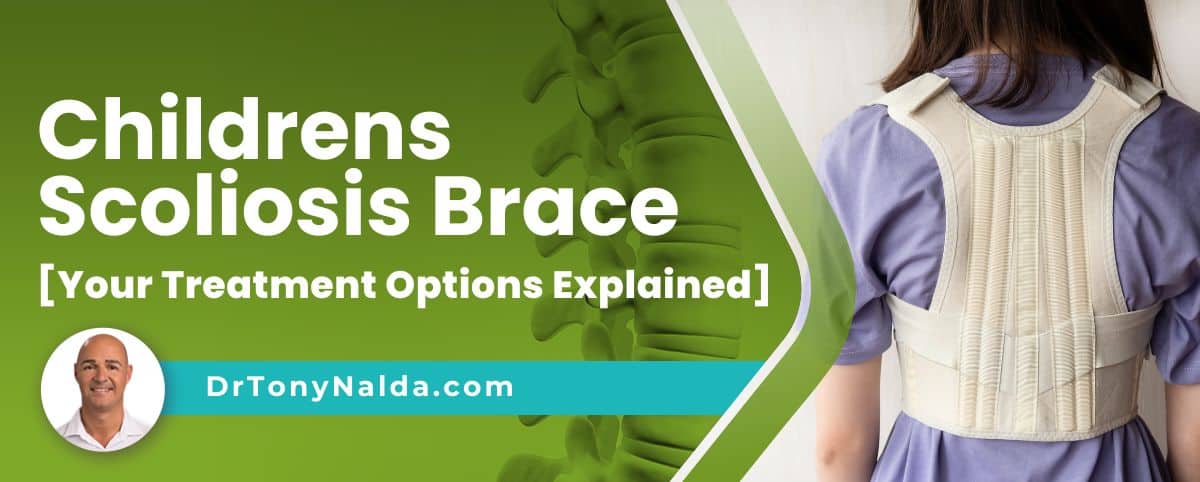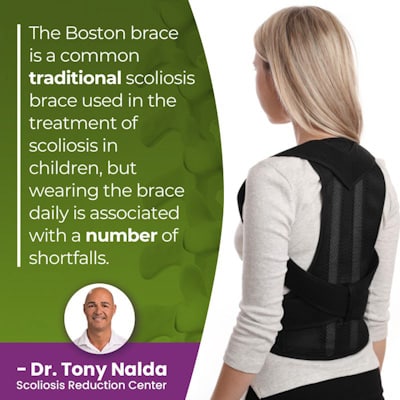Childrens Scoliosis Brace [Your Treatment Options Explained]

Childhood scoliosis needs to be taken seriously, and as a parent and/or caregiver of a child recently diagnosed, there can be overwhelming pressure to make the right treatment choice. The best thing to do is be empowered with information so an informed treatment, and brace, decision can be made.
Not only is scoliosis a progressive and incurable condition; progression is triggered by growth. Scoliosis braces can be particularly effective on growing spines, but not all braces are created equal; understanding the difference between traditional and corrective bracing is important.
Most braces for children have a curvature reduction as their end goal, but those on the path of traditional treatment will wear a traditional back brace with the goal of stopping progression: an important distinction.
Table of Contents
Scoliosis Treatment Approach
Scoliosis is a complex 3-dimensional progressive spinal condition that affects all ages and is highly prevalent; in fact, current estimates have close to seven million people currently living with scoliosis in the United States alone.
When a child is diagnosed, this means they have developed an unnatural sideways and rotating spinal curve, and this introduces a lot of uneven forces to the spine, surrounding muscles and nerves, and the entire body.
As a progressive condition, scoliosis is virtually guaranteed to get worse over time, and that means the size of the unnatural spinal curve is going to increase, as are the condition's uneven forces, and their effects.
In children, the condition's most-noticeable effect is postural deviation, and the condition's most-noticeable effect in adults is pain; scoliosis becomes a compressive condition once skeletal maturity has been reached.
Most cases of childhood scoliosis are idiopathic scoliosis, meaning cause unknown, but we know it's growth that triggers progression, so counteracting progression during growth is a focus of a conservative treatment approach, along with impacting the condition's underlying structural nature.
A traditional treatment approach has the goal of stopping progression, and because the goals and process of the two main scoliosis treatment approaches differ, they favor a different type of brace.
The main type of traditional scoliosis brace used is the boston brace, and the brace of choice for conservative treatment uses corrective pressure applied by the ultra-corrective ScoliBrace.
Childhood Scoliosis Bracing
The idea behind scoliosis bracing is that wearing a scoliosis brace can apply pressure along certain points of the unnatural spinal curve, and this moves the spine into a straighter alignment, but different braces have different designs, treatment goals, and potential outcomes to consider.
I also want to be clear that no scoliosis brace on its own can address scoliosis on all levels the way it needs to be, but when combined with other scoliosis-specific treatment disciplines with corrective potential, it can help augment corrective treatment results.
In traditional treatment, watching and waiting is commonly followed by bracing, and then surgery when/if a patient progresses into the severe classification.
Under conservative treatment, a child's spinal curvature is addressed proactively by starting treatment as close to the time of diagnosis as possible, and this involves integrating corrective bracing into treatment plans that combine chiropractic care, physical therapy and scoliosis-specific exercise, with corrective bracing.
To explore the difference between other braces and corrective bracing, let's take a look at the most commonly-used brace in traditional treatment: the boston brace.
Traditional Scoliosis Brace: Boston Brace
 It's important for parents and/or caregivers of a child recently diagnosed to understand that different treatment approaches favor different types of braces because they are designed around the same goal, and in traditional treatment, the goal is about stopping progression.
It's important for parents and/or caregivers of a child recently diagnosed to understand that different treatment approaches favor different types of braces because they are designed around the same goal, and in traditional treatment, the goal is about stopping progression.
The Boston brace is a common traditional scoliosis brace used in the treatment of scoliosis in children, but wearing the brace daily is associated with a number of shortfalls.
The Boston is a rigid back brace that attempts to stop progression by squeezing the spine into a straighter alignment, but this type of squeezing pressure is known to weaken a scoliotic spine over time, and in addition, because of the condition's rotational component, scoliosis is a 3-dimensional condition, but the Boston only addresses scoliosis as a 2-dimensional condition, so is already limited in its potential efficacy.
Scoliosis is diagnosed in children of all ages, but the most prevalent type overall is adolescent idiopathic scoliosis, diagnosed between the ages of 10 and 18, and for this age group in particular, they don't want to stand out, look different than their peers, walk differently, and they certainly don't want to have to live in a full-time scoliosis brace.
Full time bracing can mean wearing it for up to 23 hours a day and up to five years and/or when skeletal maturity has been reached, so compliance can be a big issue with traditional braces that tend to be rigid, not customized to suit a patient's body/curvature type, are bulky to wear, can cause skin chafing, and/or breathing issues.
The Boston is also limited in its potential efficacy because of the treatment approach it's associated with; fortunately, there is conservative treatment that offers patients a nonsurgical alternative and the benefit of modern ultra-corrective bracing.
While there is still a place for traditional scoliosis treatment and surgical intervention, for those interested in trying less-invasive nonsurgical treatments first, I encourage patients to consider the benefits of conservative treatment.
Additional traditional braces to be considered by those committing to traditional treatment include the Providence brace, Rigo Cheneau brace, and the Charleston bending brace.
Conservative Scoliosis Brace: ScoliBrace
Here at the Scoliosis Reduction Center, patients benefit from a proactive conservative treatment approach that integrates multiple different types of treatment so conditions are impacted on every level, and bracing is a common facet of treatment for correcting a child's spine affected by scoliosis.
The ultra-corrective ScoliBrace is the brace of choice in conservative treatment because of its corrective potential and how it addresses many of the shortcomings associated with traditional bracing.
The ScoliBrace uses state-of-the-art technology to comprehensively measure the body and curvature type of each patient to ensure that every brace is 100-percent bespoke to its wearer, and this has greatly improved compliance rates; in addition, the ScoliBrace is made from lightweight and durable material that can be concealed under loose fitting clothing and is more comfortable to wear.
 The ScoliBrace can be easily opened and closed at the front, and additional patterns/fabrics available give young patients the option of further customizing the look of their brace.
The ScoliBrace can be easily opened and closed at the front, and additional patterns/fabrics available give young patients the option of further customizing the look of their brace.
Most importantly, the ScoliBrace addresses the condition's rotation so addresses its true 3-dimensional nature, and it works by pushing the spine into a corrective position, instead of squeezing it and weakening it over time.
The ScoliBrace offers corrective results because it's combined with other scoliosis-specific treatment disciplines that complement one another.
A child's scoliosis has to be treated proactively because as a progressive condition triggered by growth, a rapid growth spurt can cause rapid progression, and scoliosis only gets more complex to treat the more severe it becomes.
Conclusion
It can be overwhelming to have a child diagnosed with a progressive structural spinal condition like scoliosis, but we know a lot more about scoliosis now than we did in the past, and the power and results of corrective bracing and conservative treatment are proven.
Traditional scoliosis treatment offers traditional bracing, which commonly includes the Boston brace, limited in its potential efficacy, while conservative scoliosis treatment opts for the corrective potential of the ScoliBrace: representing the culmination of what we've learned about scoliosis and brace efficacy over the years.
As a child grows, they can face progression and increasing condition effects, and these include postural changes such as uneven shoulders, hips, and the development of a rib cage arch, and additional disruptions to balance, coordination, and gait are also common.
Scoliosis introduces uneven forces to the spine, its surroundings, and the entire body, and as a complex 3-dimensional condition, scoliosis needs to be impacted on every level, and while there are never treatment guarantees, particularly in childhood scoliosis, early detection and intervention can be highly beneficial; mild scoliosis is simpler to treat than moderate scoliosis, and moderate scoliosis is simpler to treat than severe and very severe scoliosis.
When a child's treatment is started early in a condition's progressive line, scoliosis can be highly treatable, and with conservative treatment and the power of corrective bracing, a curvature reduction can be worked towards, and core strength can be increased for optimal spinal support/stabilization.
A child with scoliosis is more likely to feel self-conscious, so being aware of the different brace options available, along with the different treatment approaches, can help have a positive effect throughout treatment and beyond.
Dr. Tony Nalda
DOCTOR OF CHIROPRACTIC
After receiving an undergraduate degree in psychology and his Doctorate of Chiropractic from Life University, Dr. Nalda settled in Celebration, Florida and proceeded to build one of Central Florida’s most successful chiropractic clinics.
His experience with patients suffering from scoliosis, and the confusion and frustration they faced, led him to seek a specialty in scoliosis care. In 2006 he completed his Intensive Care Certification from CLEAR Institute, a leading scoliosis educational and certification center.
About Dr. Tony Nalda
 Ready to explore scoliosis treatment? Contact Us Now
Ready to explore scoliosis treatment? Contact Us Now





